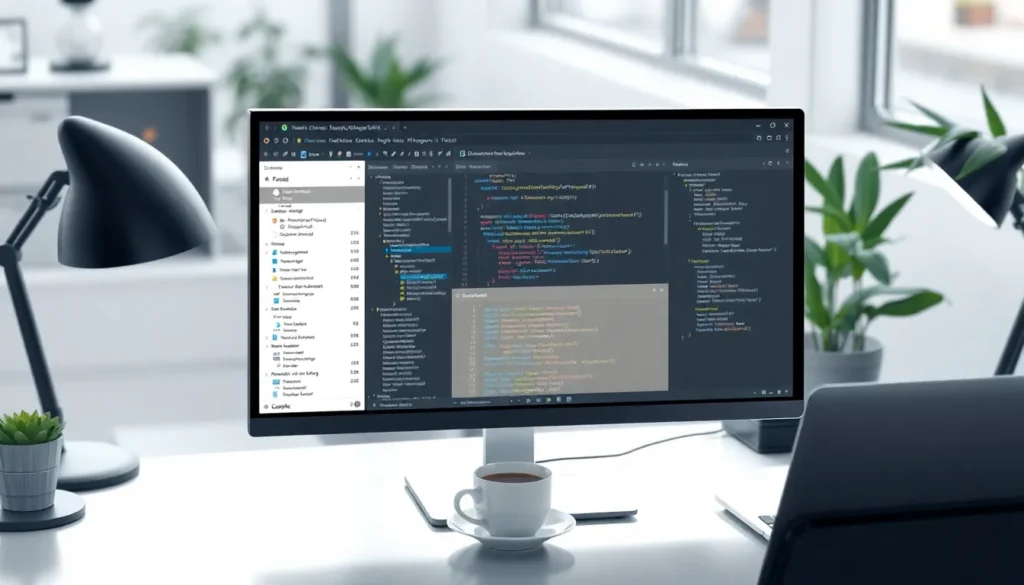Navigating the vast world of web development can feel like trying to find a needle in a haystack—if that needle had a million different colors and sizes. Enter Chrome DevTools shortcuts, the unsung heroes that can turn a frustrating search into a smooth sail. These nifty little combinations not only save time but also make debugging feel like a walk in the park, minus the mosquitoes.
Chrome Devtools Shortcut
Chrome DevTools constitutes a powerful suite of web development tools embedded in the Google Chrome browser. These tools provide developers with the ability to inspect, debug, and optimize web applications directly from the browser. Accessing DevTools presents options to view various aspects of web pages, including html, css, and JavaScript performance.
Inspecting the Document Object Model (DOM) helps developers visualize the structure of web pages. Examining elements within the DOM allows for real-time adjustments and testing. Experimenting with css properties facilitates immediate feedback on visual changes, enhancing the design process.
Network analysis tools in Chrome DevTools enable users to track requests and responses. Developers can monitor load times for resources, identify bottlenecks, and optimize performance through these insights. Utilizing the performance panel showcases rendering times and offers suggestions for improvement.
JavaScript debugging proves essential for identifying and resolving errors. The sources panel allows setting breakpoints and stepping through code line by line. Managing async calls and closures becomes straightforward with these capabilities.
Furthermore, users can leverage the application panel to inspect service workers and storage. This functionality aids in managing application data and enhancing offline capabilities. Emphasizing accessibility remains crucial, as DevTools includes features to analyze accessibility issues and suggest enhancements.
Chrome DevTools streamline the web development process, enabling faster debugging and performance optimization. Implementing keyboard shortcuts enhances efficiency, allowing developers to access features quickly, making the development experience more productive.
Importance of Shortcuts

Shortcuts in Chrome DevTools significantly enhance web development practices. They enable developers to navigate through complex tasks swiftly, ensuring that time spent on debugging and optimization gets minimized.
Efficiency in Web Development
Efficiency shines in web development through shortcuts. Developers can execute commands faster, which leads to quicker resolutions of issues. By reducing the time spent on manual tasks, developers can focus their efforts on refining code and improving website performance. A prime example is using shortcuts for quickly accessing the Elements panel or Console. This immediate access allows adjustments to be tested in real-time, resulting in a streamlined workflow.
Enhancing Productivity
Productivity increases when developers utilize Chrome DevTools shortcuts. Shortcuts allow developers to multitask effectively, making it easier to switch between panels without losing focus. For instance, keyboard combinations provide instant openings to various debugging tools. In addition, fewer clicks translate to reduced physical strain and cognitive load. The ease of accessing resources encourages deeper exploration of features, helping developers learn and apply new techniques rapidly. Overall, these shortcuts drive a more productive development environment.
Common Chrome DevTools Shortcuts
Developers use numerous shortcuts in Chrome DevTools to streamline their workflow. These shortcuts enable quick navigation, efficient inspection, and effective debugging of web applications.
Navigation Shortcuts
Navigation shortcuts enhance the speed at which developers maneuver through DevTools. Pressing Ctrl + Shift + I (or Cmd + Option + I on Mac) opens the DevTools panel. Developers switch between panels using Ctrl + [ or ] (or Cmd + [ or ] on Mac), facilitating seamless transitions. The Esc key toggles the console, allowing quick access to logs and executions. Additional shortcuts, like Ctrl + P (or Cmd + P on Mac), open files in the Sources panel. These navigation shortcuts significantly reduce the time spent locating tools within the interface.
Inspection Shortcuts
Inspection shortcuts enable efficient examination of web page elements. To select an element on the page, pressing Ctrl + Shift + C (or Cmd + Shift + C on Mac) activates the element selector tool. This feature allows developers to quickly inspect the Document Object Model (DOM). After locating an element, F2 facilitates renaming, making adjustments straightforward. Additionally, Ctrl + Shift + E (or Cmd + Shift + E on Mac) displays the responsive design view, providing insights into various screen sizes. Each inspection shortcut streamlines the adjustment process, improving productivity.
Debugging Shortcuts
Debugging shortcuts provide essential tools for identifying and resolving errors in web applications. Developers can pause script execution by pressing F8, making it easier to analyze specific issues. The F10 key steps over functions, while F11 steps into functions for detailed investigation. Console logging also benefits from shortcuts, like Ctrl + L, which clears the console output instantly. Further, Ctrl + Shift + L expands or collapses all breakpoints, allowing quick management of debugging points. These debugging shortcuts increase efficiency and promote faster resolution of coding issues.
Customizing Shortcuts
Customizing shortcuts in Chrome DevTools allows users to tailor their workflow. It enables developers to increase efficiency with personalized commands.
Creating Personalized Shortcuts
Creating personalized shortcuts in Chrome DevTools is straightforward. Users navigate to the settings panel and select “Shortcuts.” They can click individual actions and assign new key combinations. For example, if a developer prefers using a specific key sequence for opening the console, they can easily change it. Adapting shortcuts to personal preferences enhances workflow and speeds up routine tasks. Users can improve their overall experience by customizing these commands to better suit their habits.
Resetting to Default
Resetting shortcuts to default settings can resolve issues or simplify the interface. Developers can revert changes if personalized shortcuts become confusing or counterproductive. This process takes place in the same settings panel where shortcuts are modified. By selecting the reset option, developers restore all command configurations to their original state. It’s a simple yet effective way to return to familiar controls. Reverting to default settings also helps maintain a consistent environment, especially for teams collaborating on projects.
Conclusion
Embracing Chrome DevTools shortcuts can significantly transform a developer’s workflow. By utilizing these time-saving tools, developers can streamline their processes and enhance productivity. The ability to navigate, inspect, and debug efficiently fosters a more effective development environment.
Customization options further empower users to tailor their experience, ensuring that their unique needs are met. As developers become more adept at using these shortcuts, they can focus on refining their code and improving website performance. Ultimately, mastering Chrome DevTools shortcuts not only simplifies complex tasks but also encourages a deeper exploration of web development techniques.



